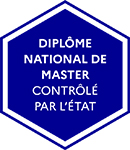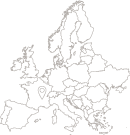Présentation
Master Optique, Image, Vision, Multimédia Parcours Photonics Engineering
Objectifs
Le programme pédagogique repose sur des cours fondamentaux, des cours pratiques et des cours d'approfondissement à l'interface entre l'optique, la photonique et la simulation. Ils permettent une spécialisation progressive pour former des professionnels qui pourront développer une activité de recherche-ingénierie dans les secteurs disciplinaires liés à la physique appliquée, l'optique, la photonique, les capteurs à fibre optique, la structuration de surface par laser aux échelles micro et nanométriques, la modélisation et la caractérisation optique, physique et mathématique des surfaces et des interfaces structurées, entre autres applications.
Le parcours Photonics Engineering a été créé pour offrir des cours académiques sur les multiples interactions entre l'optique, l'interaction lumière-matière et les propriétés des surfaces et interfaces :
- Réalisation de micro-nano-structuration de matériaux (applications en Mécanique, Biologie, Chimie, Aéronautique et Espace, Technologies médicales et de soins, Sécurité),
- Réalisation de structure photonique dans les matériaux massifs ou les fibres optiques (applications en Aéronautique et Espace, Technologies médicales et de soins, Sécurité),
- Caractérisation des surfaces à l'aide de techniques modernes d'optique et de champ proche : SEM, TEM, EDX, AES, XPS, AFM, ...,
- Simulation et conception de surfaces micro-nano-structurées ainsi que de structures photoniques pour une application donnée.
L’équipe pédagogique est aussi attentive à délivrer un enseignement qui soit adapté aux besoins de l’industrie, ouvert aux technologies novatrices (nanotechnologies, traçabilité sécurisée, imagerie couleur et application multimédia) et orienté vers la professionnalisation (instrumentation photonique, contrôle, analyse et traitement des images).
The Photonics Engineering programme is based on fundamental courses, practical courses and in-depth courses at the interface between optics, photonics, and computer science. They allow a progressive specialisation to train professionals who will be able to develop a research-engineering activity in the disciplinary sectors related to applied physics, optics, photonics, fiber optic sensors, surface structuring by laser at micro and nanometric scales, modelling and optical, physical and mathematical characterisation of surfaces and structured interfaces, among other applications.
The “Photonics Engineering” track offers academic courses on the multiple interactions between Optic, light-matter interaction and surface and interface properties for:
- The realisation of micro-nano-structuring of materials (applications in Mechanics, Biology, Chemistry, Aeronautics and Space, Medical and Care technologies, Security),
- The realisation of photonic structures in either bulk materials or optical fiber (applications in Aeronautics and Space, Medical and Care technologies, Security),
- The characterization of surfaces with up-to-date optical and near field technics: SEM, TEM, EDX, AES, XPS, AFM, ...,
- The simulation and the design of either micro-nano-structured surfaces or photonic structures for a given application.
The teaching team is also careful to provide teaching that is open to innovative technologies (nanotechnologies, secure traceability, colour imaging and multimedia applications) and oriented towards professionalization (photonic instrumentation).
Pour qui ?
Conditions d'admission
Les candidats doivent avoir un parcours en Physique avec des connaissances en optique-photonique, électromagnétique, interférences et diffraction, mécanique quantique, programmation informatique (Matlab/Pyhton, etc.), électricité et électronique.
CANDIDATURE EN MASTER 1
Les étudiants français ou étrangers titulaires d'un diplôme français doivent candidater sur Mon Master
Vague principale : du 25 février 2025 au 24 mars 2025
Vague complémentaire : du 17 juin 2025 au 23 juin 2025
LES CANDIDATURES SONT TERMINÉES
Les étudiants étrangers (UE et hors UE), y compris les étudiants "Études en France" (Campus France), doivent postuler sur International Master Degrees Application
CANDIDATURE EN MASTER 2
Les étudiants français ou étrangers titulaires d'un diplôme français doivent candidater sur eCandidats
Vague principale : 1er avril 2025 au 16 mai 2025
Vague complémentaire : du 24 juin 2025 au 6 juillet 2025
LES CANDIDATURES SONT TERMINÉES
Les étudiants étrangers (UE et hors UE), y compris les étudiants "Études en France" (Campus France), doivent postuler sur International Master Degrees Application
ADMISSION CRITERIA
Applicants must hold a Bachelor's degree level in Mathematics or Physics and have a background in optics (electromagnetism, geometrical optics, optical instrumentation) and software programming (Matlab, Python, etc.).
APPLICATION IN MASTER 1
French or foreign students with a French degree must apply on Mon Master
From 26/02/2025 to 24/03/2025 - NOW CLOSED
Complementary phase: from 17/06/2025 to 23/06/2025 - NOW CLOSED
Foreign students, including "Études en France" students (Campus France), must apply on International Master Degrees Application
APPLICATION IN MASTER 2
French or foreign students with a French degree must apply on eCandidats
From 01/04/2025 to 16/05/2025 - NOW CLOSED
Complementary phase: from 24/06/2025 to 06/07/2025 - NOW CLOSED
Foreign students, including "Études en France" students (Campus France), must apply on International Master Degrees Application
Et après ?
Poursuites d'études
Le Master OIVM-Photonics Engineering est conçu pour répondre aux besoins et aux défis des industries. Il ouvre également sur des opportunités de carrières internationales et stimulantes, puisque le besoin d’étudiants diplômés de master est croissant dans les domaines liés aux surfaces et interfaces – propriétés, caractérisation, applications et modifications (principalement optique par laser femtoseconde). Les étudiants ont l’opportunité de poursuivre leurs études en doctorat.
The Master OIVM-Photonics Engineering is designed to address industries’ needs and challenges. It also opens up for international and challenging career opportunities, since the demand for postgraduates related to surface and interfaces – properties, characterizations, applications and modifications (mainly optical fs-laser) is very high on the international job market. Students can also pursue their studies with a PhD.
Partenaires
Etablissement(s) partenaire(s)
Informations supplémentaires
Le parcours Photonics Engineering fait partie de la Graduate School Manutech-SLEIGHT, un programme intégré de formation par et pour la recherche dans les domaines de l'ingénierie lumière-surfaces (optique-photonique, ingénierie des surfaces, sciences de l'image, informatique et ingénierie de la santé). Les étudiants auront des opportunités de stages en collaboration avec des laboratoires ou entreprises reconnus, et ils participeront et seront acteurs des SLEIGHT Science Events (un événement bisannuel et multidisciplinaire où ils pourront découvrir l'état de la recherche dans les domaines de Manutech-SLEIGHT et construire leur réseau). La Graduate School offre également des bourses d'attractivité et des bourses de mobilité.
The Photonics Engineering track is part of the Manutech-SLEIGHT Graduate School, a unique integrated training by and for research programme in the fields of light-surfaces engineering (Optics-Photonics, Surface Engineering, Image and Computer Science and Health Engineering). Integrating the Graduate School is a great opportunity for master students. They will learn on a dynamic site in Saint-Etienne (France) recognised at the highest international level in these research domains. Students will have large possibilities to carry out internships in collaboration with recognised laboratories or companies, they will participate and be actors of the SLEIGHT Science Events (a biannual and multidisciplinary event where they will discover the state of the research in the Manutech-SLEIGHT’s domains and build their network). The Graduate School also offers attractiveness scholarships and mobility grants.
Cursus 100% English
For more information : www.manutech-sleight.com
Contact
Nathalie DESTOUCHES
Responsable pédagogique du Master OIVM
nathalie.destouches @ univ-st-etienne.fr (nathalie.destouches @ univ-st-etienne.fr)
Ciro D'AMICO
Responsable pédagogique du parcours PE M1
ciro.damico @ univ-st-etienne.fr (ciro.damico @ univ-st-etienne.fr)
Emmanuel MARIN
Responsable pédagogique du parcours PE M2
emmanuel.marin @ univ-st-etienne.fr (emmanuel.marin @ univ-st-etienne.fr)
Master PE
manufacture-scolarite @ univ-st-etienne.fr (manufacture-scolarite @ univ-st-etienne.fr)
+33 (0)4 77 91 57 30
Programme
Master Optique, Image, Vision, Multimédia Parcours Photonics Engineering
Programme
SEMESTER 7
UE 1 : Culture générale et préparation à la vie professionnelle 1 : 5 ECTS
- Foreign language : les étudiantes/étudiants choisissent 1 élément parmi les 2 suivants :
- Anglais UJM : 2 ECTS
Français Langue Étrangère : 2 ECTS
- Anglais UJM : 2 ECTS
- PVP1 : 1 ECTS
- Scientific Computing with Python : 2 ECTS
UE2 : Laser matter interaction : 8 ECTS
- Laser Physics : 4 ECTS
- Fiber lasers : 1 ECTS
- Photon-atome coupling : 3 ECTS
UE3 : Physical and fourier optics : 5 ECTS
- Physical and fourier optics : 3 ECTS
- Digital Holography: numerical simulation and reconstruction (Python) : 2 ECTS
UE4 : Optics in condensed phase : 5 ECTS
- Introduction to guided optics : 2 ECTS
- Optical engineering : 3 ECTS
UE5 : Mesurement of light radiation : 7 ECTS
- Introduction to radiometry : 1 ECTS
- Radiometry of optical systems : 2 ECTS
- Radiometry of surfaces and media : 2 ECTS
- Colorimetry : 2 ECTS
SEMESTER 8
UE 1 : Culture générale et préparation à la vie professionnelle 2 : 3 ECTS
- Foreign language : les étudiantes/étudiants choisissent 1 élément parmi les 2 suivants :
- Anglais UJM : 2 ECTS
Français Langue Étrangère : 2 ECTS
- Anglais UJM : 2 ECTS
- PVP2 : 1 ECTS
UE2 : Laser and laser matter interaction : 6 ECTS
- From the atomic structure to the dielectric function : 4 ECTS
- Collective behavior of matter under electromagnetic radiation : 2 ECTS
UE3 : Optical systems : 4 ECTS
- Optics of anisotropic media : 2 ECTS
- Thin films : 2 ECTS
UE4 : Scientific project and methodology : 6 ECTS
- TP PROJETS : 4 ECTS
- Scientific methodology (online) and project Management : 2 ECTS
UE5 : Internship in lab or industry/ter : 11 ECTS
SEMESTER 9
UE 1 : Culture générale et préparation à la vie professionnelle 3 : 4 ECTS
- Foreign language : les étudiantes/étudiants choisissent 1 élément parmi les 2 suivants :
- Anglais UJM : 2 ECTS
Français Langue Étrangère : 2 ECTS
- Anglais UJM : 2 ECTS
- PVP 3 : conduite de projet : 2 ECTS
UE2 : Material characterisation and analysis : 6 ECTS
- Optical microscopy : 2 ECTS
- Material analysis : 2 ECTS
- Non-optical surface properties : 2 ECTS
UE3 : Laser structuring : 7 ECTS
- Laser processes for material structuring : 2 ECTS
- Electromagnetic modeling of laser structuring : 3 ECTS
- Temporal and spatial shaping of the laser pulse : 1 ECTS
- Applications of micro-nanophotonics : 1 ECTS
UE4 : Optics in confined environment : 7 ECTS
- Advanced photonics technologies : 2 ECTS
- Applications of guided optics : 1 ECTS
- Nanoplasmonics : 2 ECTS
- Non-Linear Optics : 2 ECTS
UE5 : Cours optionnel les étudiantes/étudiants choisissent 1 cours : 5 ECTS
- Radiation Effects on Photonic and Optoelectronic Technologies : 5 ECTS
- Color and spectral imaging : 5 ECTS
UE facultative : Énergie (l'étudiante/étudiant choisit le Bloc A ou le Bloc B) : 3 ECTS
- Bloc A : Physiques des LED et cellules solaires : 3 ECTS
- Bloc B : Technologies et utilisation du photovoltaique : 2 ECTS
- Bloc B : Bureau d’étude sur la conception d’éclairages : 1 ECTS
SEMESTER 10
- Master Thesis : internship : 30 ECTS
- Optical design : 4 ECTS
Diplôme Master
Domaine d'étude Sciences, Technologies, Santé
Mention Optique, image, vision, multimédia
Parcours Photonics Engineering
Faculté des Sciences et Techniques
23, rue Docteur Paul Michelon
42100 Saint-Etienne
04 77 48 15 00
fac-sciences.univ-st-etienne.fr
Organisation
Durée : 2 ans
120 crédits
Lieu d’enseignement :
- Saint-Etienne
Coût de l'inscription
€
Détail coût d'inscription
Droits d'inscription nationaux et extracommunautaires
Tarif 2025-2026 : 254 €
Contribution de vie étudiante et de campus (CVEC)
Tarif 2025-2026 : 105 €
Tuition fees
2025-2026 fees: €254
Student and Campus Life Contribution (CVEC)
2025-2026 fees: €105
Plus d'informations/more information:
service-public.fr
etudiant.gouv.fr
Comprendre la CVEC



